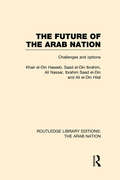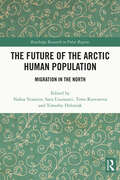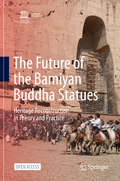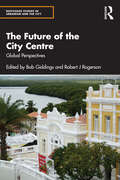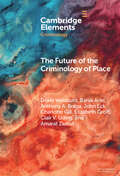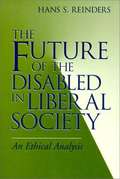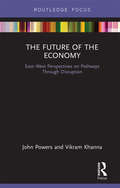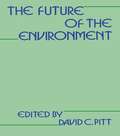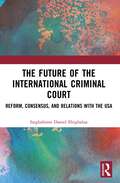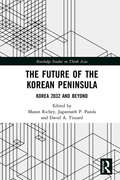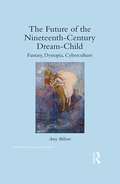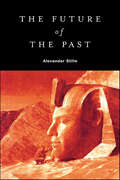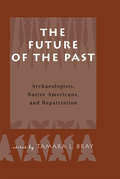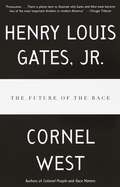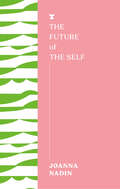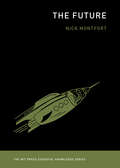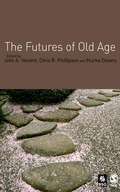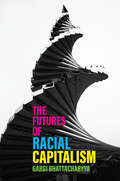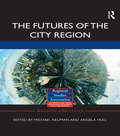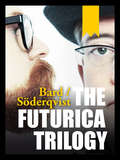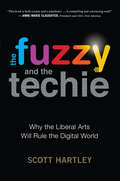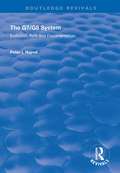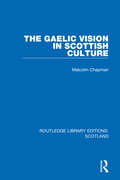- Table View
- List View
The Future of the Arab Nation: Challenges and Options (Routledge Library Editions: The Arab Nation)
by Roger Owen Khair el-Din Haseeb Saad el-Din Ibrahim Ali Nassar Ibrahim Saad el-Din Ali el-Din HilalWhat is the place of the Arab states as a new world order emerges? How can the Arab world respond positively to change as the new Europe emerges, political relationships are restructured, and the information revolution transforms the global economy? To what extent are the Arab states in danger of falling prey to increasing disunity and fragmentation? The book is the result of a major research programme in which Arab social scientists outline some of the paths which could be taken by the Arab world over the next 25 years. It presents a detailed analysis of resources in the Arab world – including population, employment, oil and water supplies and the trade and investment situation. The authors argue for greater popular participation and reassert the argument that only by pooling resources effectively can the Arab states establish their place in a world of national and supra-national blocs.
The Future of the Arctic Human Population: Migration in the North (Routledge Research in Polar Regions)
by Timo Koivurova Satu Uusiautti Nafisa Yeasmin Timothy HeleniakThe Future of the Arctic Human Population seeks to explore the challenges of Arctic migration, immigrants, and refugees and how integrated societies can be developed. Moreover, it discusses disparities between regions on policies and their implementation. This book explores how cross-border cooperation is needed to provide innovative solutions to migration challenges such as cultural differences, acceptance, and integration into local communities, and joining the labour market. It examines whether there are regional differences in well-being among immigrants in Arctic countries. The book considers how we can build and model integrated societies, and what tools and measure can be used to assess inclusive and resilient societies.
The Future of the Bamiyan Buddha Statues: Heritage Reconstruction in Theory and Practice
by Masanori NagaokaThis Open Access book explores heritage conservation ethics of post conflict and provides an important historical record of the possible reconstruction of the Bamiyan Buddha statues, which was inscribed in the UNESCO World Heritage List in Danger in 2003 as “Cultural Landscape and Archaeological Remains of the Bamiyan Valley”. With the condition that most surface of the original fragments of the Buddha statues were lost due to acts of deliberate destruction, this publication explores a reference point for conservation practitioners and policy makers around the world as they consider how to respond to on-going acts of destruction of cultural heritage.Whilst there has been an emerging debate to the ethics and nature of heritage reconstruction, this volume provides a plethora of ideas and approaches concerning the future treatment of the Bamiyan Buddha statues. It also addresses a number of fundamental questions on potential heritage reconstruction: how it will be done; who will decide; and what it should be done for. Moreover when it comes to the inscribed World Heritage properties, how can reconstructed heritage using non-original materials be considered to retain authenticity? With a view to serving as a precedent for potential decisions taken elsewhere in the world for cultural properties impacted by acts of violence and destruction, this volume introduces academic researches, experiences and observations of heritage conservation theory and practice of heritage reconstruction. It also addresses the issue not merely from the point of a material conservation philosophy but within the context of holistic strategies for the protection of human rights and promotion of peace building.
The Future of the City Centre: Global Perspectives (Routledge Studies in Urbanism and the City)
by Bob Giddings Robert J RogersonThe Future of the City Centre: Global Perspectives debates future directions. It looks beyond the post-industrial, post-commercial, and post-retail city centres to examine differing visions of the future form and function of the urban core. This theme and the related sub-topics will assist the development of future city models and help to contextualise urban change. The in-depth research covers not only urban form and the re-use of the built heritage but also the provision for cultural events and different forms of entertainment that will offer vitality, together with visitors and responsible tourism. City authorities are starting to realise that structural changes are happening in city centres, as their influence is declining, and therefore new forms of governance will be needed. The book is based on an international research network hosting four symposia over 24 months. They took place in four cities in four different continents to encompass a world view of developed and developing countries. This book offers theoretical and practical perspectives from leading thinkers, academics, and practitioners, drawing on thematic issues explored across four international cities: Newcastle, UK; Newcastle, Australia; Pretoria-Tshwane, South Africa; and João Pessoa, Brazil. It draws on a wider set of global examples to reveal the shared issues and pressures being brought to bear on city centres and the diversity of responses being undertaken to ensure their long-term future. The book includes illustrations from cities around the world, and it is directed at academics, students, and professionals in architecture, planning, urban design, the built environment, geography, economics, sociology, and cultural studies.
The Future of the Criminology of Place: New Directions for Research and Practice (Elements in Criminology)
by David Weisburd Barak Ariel Anthony A. Braga John Eck Charlotte Gill Elizabeth Groff Clair V. Uding Amarat ZaatutMicrogeographic units of analysis have moved to the center of criminological inquiry. This Element brings together leading crime-and-place scholars to identify promising areas for future study. Section 1 introduces the Element and the importance of focusing on the future of studies of crime and place. Section 2 examines the development of hot-spots policing and the importance of focusing on its impact on communities. It also looks at how 'pracademics' can advance the science and practice of place-based policing. Section 3 focuses on place managers as prevention agents and examines how city government can influence crime at place. It further contends that rural communities need to become a key focus of crime-and-place scholarship. Section 4 emphasizes the importance of the connection of health, crime, and place. It also argues for the importance of expanding the methodological tools of crime and place to include careful ethnographic and qualitative research.
The Future of the Disabled in Liberal Society: An Ethical Analysis
by Hans S. ReindersIn this book, Reinders points out that the possibility of preventing disabled lives is at odds with our commitment to the full inclusion of disabled citizens in society. This powerful critique of contemporary bioethics is sure to become required reading for those interested in human development, special education, ethics, philosophy, and theology.
The Future of the Economy: East-West Perspectives on Pathways Through Disruption (Routledge Studies in the Modern World Economy)
by John Powers Vikram KhannaAs the pace of economic change seems to only quicken, including rapid technological advance, today’s advanced economies face uncertainty from a number of directions, most of which have the potential to change established modes of thinking and the institutional arrangements that underpin basic economic organization. Labor-saving technological advances are accompanied by risks to jobs due to automation. Work is being made more insecure for a wide variety of workers and skill levels because of shifting capital–labor relationships. Regulatory systems are scrambling to adapt to new technologies in infrastructure planning or to the classification of workers under rapidly proliferating "alternative work arrangements." Even the ties that bind groups of countries together in often long-standing bilateral and multilateral trade relationships are increasingly under strain with the rise of populist economic nationalism in some of the world’s largest economies. Crucial changes are taking place that risk eroding structures of opportunity, as well as public confidence in the institutions charged with economic policy making in many countries. The expert views contained in this book will be valuable to the reader studying or working on the many overlapping issues of economy, technology, and society and thus looking for insights into some of the most pertinent topics in today’s advanced economies. Taking a multidimensional view, this book synthesizes the main issues and dilemmas facing the economy of the future, seeks to frame the trade-offs in policy terms, while also advancing the discussion towards recommendations and solutions. It focuses on the intersection of work, technology, society, infrastructure, and the economic role of government. In this way, the book is centered on some of the most tangible areas of economic structure that reproduce the gains of growth, but it also addresses matters related to the distribution effects and measures that can produce more inclusive and productive outcomes, including the fundamental role of policy and regulation.
The Future of the Environment: The Social Dimensions Of Conservation And Ecological Alternatives (European Year Of The Environment Ser.)
by David PittA major concern of this book is how ordinary people might come to manage their own environment more effectively. A valuable resource for students of environmental studies, it considers how this might be facilitated by more appropriate technology, assistance and communications. Reviewed by the International Journal of Environmental Studies, it has`... something of interest and information in every chapter of this book and I urge all readers to look at it carefully, for its combination of the examination of general principles and down-to-earth data and problems is one of the best for years'.
The Future of the Highlands (Routledge Library Editions: Scotland #29)
by Derick S. Thomson Ian GrimbleOriginally published in 1968, this book gave a rounded picture of some of the problems which were facing the Highlands of Scotland in the first half of the twentieth century. The contributors examined various aspects of the Highland problem and ways of solving it: how to develop productive industry, stabilize the population, encourage creative growth of community and support Gaelic culture and language. The book takes full account of the historical background, linguistic, literary and economic situation.
The Future of the International Criminal Court: Reform, Consensus, and Relations with the USA
by Iseghohime Daniel EhighaluaThis book presents the argument that solution-driven policy and treaty changes, if faithfully implemented, will rekindle the relevance of the International Criminal Court (ICC) in combatting and prosecuting atrocity crimes. This work examines how the International Criminal Court could be re-envisioned to perform optimally, and why such reform is urgent. It also discusses the position of the USA towards the court and explores why it has been unable to transition from marginal engagement to full spectrum support by signing and ratifying the Rome Treaty 1998. The conceptual frameworks deployed range from how the US construes its ‘national interest’ to geo-political balancing and the present rudderless state of the rules order, in addition to the personal predilections of US Presidents and the Court’s dysfunctional state. The objective is to show that if the ICC does not engender reforms internally, it will not survive the fissiparous tendencies innate in the presently fractured rules order. The work argues that only foundational reforms around treaty amendments along with institutional realignment of roles and responsibilities of the Court’s principal officers will yet rescue it. The book will be of interest to researchers, academics and policy-makers working in the areas of International Criminal Law and International Relations.
The Future of the Korean Peninsula: Korea 2032 and Beyond (Routledge Studies on Think Asia)
by Mason RicheyThis book considers both Koreas - North Korea and South Korea - to examine possible pathways for the years leading up to 2032 and beyond, thus offering a composite picture of Korea and its strategic relevance in Asia and the world at large. Through a combined South-North Olympic team and an effort of jointly hosting the Games, Republic of Korea president Moon Jae-in has marked the year 2032 as special in the future of the Korean Peninsula. Although the International Olympic Committee (IOC) has expressed scepticism about a combined hosting of the Games, the expectation in Korea is that this event will underline the shared destiny of the people inhabiting the peninsula and realign two states still caught in an ideologically fraught civil conflict that is one of the last vestiges of the Cold War. Chapters begin with a brief historical review and analysis of the present, before moving to consider how these will shape the next decade, drawing comparative and complementary analyses. No matter how contrasting the contemporary trajectories of both North and South Korea might appear, ‘Korea’ as a singular entity is an old concept still containing great possibilities. As the ongoing inter-Korean reconciliation process underscores, the futures of North and South Korea can be found in a complementary singular Korea, which would again represent an important political, strategic, cultural, and social space in Asia. An evaluation of the future trajectory, social awareness and perception of the Koreas, this book offers a valuable contribution to the study of North and South Korea and Asian Politics.
The Future of the Nineteenth-Century Dream-Child: Fantasy, Dystopia, Cyberculture (Children's Literature and Culture)
by Amy BilloneThis book investigates the reappearance of the 19th-century dream-child from the Golden Age of Children's Literature, both in the Harry Potter series and in other works that have reached unprecedented levels of popular success today. Discussing Harry Potter as a reincarnation of Lewis Carroll's Alice and J.M. Barrie's Peter Pan, Billone goes on to examine the recent resurrection of Alice in Tim Burton's Alice, and of Peter Pan in Michael Jackson and in James Bond. Visiting trends that have emerged since the Harry Potter series ended, the book studies revisions of the dream-child in texts and films that have inspired mass fandom in the twenty-first century: Stephenie Meyer's Twilight, E.L. James's 50 Shades of Grey and Suzanne Collins's The Hunger Games. The volume argues that the 21st-century desire to achieve dream-states in relationship to eternal youth results from the way that dreams provide a means of realizing the fantastic yet alarming possibility of escaping from time. This current identification with the dream-child stems from the threat of political unrest and economic and environmental collapse as well as from the simultaneous technophilia and technophobia of a culture immersed in the breathless revolution of the digital age. This book not only explores how the dream-child from the past has returned to reflect misgivings about imagined dystopian futures but also reveals how the rebirth of the dream-child opens up possibilities for new narratives where happy endings remain viable against all odds. It will appeal to scholars in a wide variety of fields including Childhood Studies, Children's/YA Literature, Cinema Studies, Cultural Studies, Cyberculture, Gender Studies, Queer Studies, Gothic Studies, New Media, and Popular Culture.
The Future of the Past
by Alexander StilleAn engrossing look at the cultural consequences of technological change and globalizationSpace radar, infrared photography, carbon dating, DNA analysis, microfilm, digital data bases-we have better technology than ever for studying and preserving the past. And yet the by-products of technology threaten to destroy--in one or two generations--monuments, works of art, and ways of life that have survived thousands of years of hardship and war. This paradox is central to our age. We use the Internet to access and assess infinite amounts of information--but understand less and less of its historical context. Globalization may eventually benefit countries around the world; it will also, almost certainly, lead to the disappearance of hundreds of regional dialects, languages, and whole societies.In The Future of the Past, Alexander Stille takes us on a tour of the past as it exists today and weighs its prospects for tomorrow, from China to Somalia to Washington, D.C. Through incisive portraits of their protagonists, he describes high-tech struggles to save the Great Sphinx and the Ganges; efforts to preserve Latin within the Vatican; the digital glut inside the National Archives, which may have lost more information in the information age than ever before; an oral culture threatened by a "new" technology: writing itself. Wherever it takes him, Stille explores not just the past, but our ideas about the past, how they are changing--and how they will have to change if our past is to have a future.
The Future of the Past: Archaeologists, Native Americans and Repatriation
by Tamara BrayTo date, the notion of repatriation has been formulated as a highly polarized debate with museums, archaeologists, and anthropologists on one side, and Native Americans on the other. This volume offers both a retrospective and a prospective look at the topic of repatriation. By juxtaposing the divergent views of native peoples, anthropologists, museum professionals, and members of the legal profession, it illustrates the complexity of the repatriation issue.
The Future of the Race
by Cornel West Henry Louis GatesAlmost one-hundred years ago, W.E.B. Du Bois proposed the notion of the "talented tenth," an African American elite that would serve as leaders and models for the larger black community. In this unprecedented collaboration, Henry Louis Gates, Jr., and Cornel West--two of Du Bois's most prominent intellectual descendants--reassess that relationship and its implications for the future of black Americans. If the 1990s are the best of times for the heirs of the Talented Tenth, they are unquestionably worse for the growing black underclass. As they examine the origins of this widening gulf and propose solutions for it, Gates and West combine memoir and biography, social analysis and cultural survey into a book that is incisive and compassionate, cautionary and deeply stirring.
The Future of the Self (The FUTURES Series)
by Joanna NadinExploring the changing nature of &‘self&’ through the lens of popular culture and how changes in science, philosophy, technology, and society might impact our sense of self in the future.Look in the mirror – what do you see?We all feel, instinctively, that self exists. That somewhere inside us, under the clothes, the make-up, and self-tan, lurks a hard &‘pearl&’, a kernel of truth called &‘me&’. And it&’s big business uncovering that &‘authentic&’ kernel. It&’s also a fool&’s errand, because that &‘true self&’? It doesn&’t exist.Self is no more than a story we tell ourselves. It&’s mutable, pliable as Plasticine. Worse, it&’s not even strictly autobiographical, but co-authored with those around us. And as such, there is no one version, but myriad, and the number is growing as we are exposed to ever more connections.We are already seeing the effects travel, television, and celebrity culture can have on the formation of self, but as digital and social media exposure grows, and in the advent of AI, what will happen to our sense of self? Can we become ever more multiple and adapt better to our globalised world? Or will we dissolve into narcissitic, detached &‘nobodies&’?The Future of the Self will explore our current understanding of self in both philosophical and neuroscientific terms and through the lens of popular culture. It will ask what might happen to it in the coming years, and what a &‘useful self&’ might look like in the future.
The Future: The Commodore Amiga (The MIT Press Essential Knowledge series)
by Nick MontfortHow the future has been imagined and made, through the work of writers, artists, inventors, and designers.The future is like an unwritten book. It is not something we see in a crystal ball, or can only hope to predict, like the weather. In this volume of the MIT Press's Essential Knowledge series, Nick Montfort argues that the future is something to be made, not predicted. Montfort offers what he considers essential knowledge about the future, as seen in the work of writers, artists, inventors, and designers (mainly in Western culture) who developed and described the core components of the futures they envisioned. Montfort's approach is not that of futurology or scenario planning; instead, he reports on the work of making the future—the thinkers who devoted themselves to writing pages in the unwritten book. Douglas Engelbart, Alan Kay, and Ted Nelson didn't predict the future of computing, for instance. They were three of the people who made it.Montfort focuses on how the development of technologies—with an emphasis on digital technologies—has been bound up with ideas about the future. Readers learn about kitchens of the future and the vision behind them; literary utopias, from Plato's Republic to Edward Bellamy's Looking Backward and Charlotte Perkins Gilman's Herland; the Futurama exhibit at the 1939 New York World's Fair; and what led up to Tim Berners-Lee's invention of the World Wide Web. Montfort describes the notebook computer as a human-centered alterative to the idea of the computer as a room-sized “giant brain”; speculative practice in design and science fiction; and, throughout, the best ways to imagine and build the future.
The Futures of Old Age
by Chris Phillipson Dr John A Vincent Murna DownsWhat is the future of old age? How will families, services, and economies adapt to an older population? Such questions often provoke extreme and opposing answers: some see ageing populations as having the potential to undermine economic growth and prosperity; others see new and exciting ways of living in old age. The Futures of Old Age places these questions in the context of social and political change, and assesses what the various futures of old age might be. Prepared by the British Society of Gerontology, The Futures of Old Age brings together a team of leading international gerontologists from the United Kingdom and United States, drawing on their expertise and research. The book's seven sections deal with key contemporary themes including: population ageing; households and families; health; wealth; pensions; migration; inequalities; gender and self; and identity in later life.
The Futures of Racial Capitalism
by Gargi BhattacharyyaCapitalism appears to be endlessly in crisis but without ever loosening its hold on our lives. New modes of racism and exclusion emerge, but the old ones never go away. We continue to struggle to live and survive in its wake but are unable, still now, to build commonality with each other. In this incisive book, Gargi Bhattacharyya revisits debates about racial capitalism and its violence through differentiation. Taking the four lenses of prisons, borders, debt and platforms, Bhattacharyya reveals how this moment of capitalist crisis positions humans as expendable, but differentially so, in a process that remakes longstanding racialized hierarchies. Uncovering practices and techniques embedded in the shifting processes of accumulation and state power, the chapters illuminate how value is extracted from populations through non-wage routes and indebtedness. This engaging introduction to racial capitalism offers an interlocking and insightful analysis of capitalist renewal, essential for students and scholars interested in issues of race, racism and inequality.
The Futures of the City Region: Futures Of The City Region (Regions and Cities)
by Angela Hull Michael NeumanDoes the ‘city region’ constitute a new departure in urbanisation? If so, what are the key elements of that departure? The realities of the urban in the 21st century are increasingly complex and polychromatic. The rise of global networks enabled by supranational administrations, both governmental and corporate, strongly influences and structures the management of urban life. How we conceive the city region has intellectual and practical consequences. First, in helping us grasp rapidly changing realities; and second in facilitating the flow of resources, ideas and learning to enhance the quality of life of citizens. Two themes interweave through this collection, within this broad palette. First are the socio-spatial constructs and their relationship to the empirical evidence of change in the physical and functional aspects of urban form. Second is what they mean for the spatial scales of governance. This latter theme explores territorially based understandings of intervention and the changing set of political concerns in selected case studies. In efforts to address these issues and improve upon knowledge, this collection brings together international scholars building new data-driven, cross-disciplinary theories to create new images of the city region that may prove to supplement if not supplant old ones. The book illustrates the dialectical interplay of theory and fact, time and space, and spatial and institutional which expands on our intellectual grasp of the theoretical debates on ‘city-regions’ through ‘practical knowing’, citing examples from Europe, the United States, Australasia, and beyond. This book was originally published as a Special Issue of Regional Studies.
The Futurica Trilogy
by Alexander Bard Jan SöderqvistIn the late 1990's, Swedish social theorists Alexander Bard and Jan Söderqvist started working on a radical new theory, since referred to as The Netocracy Hypothesis. At this early stage Bard & Söderqvist foresaw that the control of the internet would be the subject of the main power struggle for the next century.
The Fuzzy and the Techie: Why the Liberal Arts Will Rule the Digital World
by Scott Hartley&“Artfully explains why it is time for us to get over the false division between the human and the technical.&”—Tim Brown, CEO of IDEO and author of Change by Design Scott Hartley first heard the terms fuzzy and techie while studying political science at Stanford University. If you majored in humanities or social sciences, you were a fuzzy. If you majored in computer or hard sciences, you were a techie. While Silicon Valley is generally considered a techie stronghold, the founders of companies like Airbnb, Pinterest, Slack, LinkedIn, PayPal, Stitch Fix, Reddit, and others are all fuzzies—in other words, people with backgrounds in the liberal arts. In this brilliantly counterintuitive book, Hartley shatters assumptions about business and education today: learning to code is not enough. The soft skills—curiosity, communication, and collaboration, along with an understanding of psychology and society&’s gravest problems—are central to why technology has value. Fuzzies are the instrumental stewards of robots, artificial intelligence, and machine learning. They offer a human touch that is of equal—if not greater—importance in our technology-led world than what most techies can provide. For anyone doubting whether a well-rounded liberal arts education is practical in today&’s world, Hartley&’s work will come as an inspiring revelation. Finalist for the 2016 Financial Times/McKinsey Bracken Bower Prize and A Financial Times Business Book of the Month
The G7/G8 System: Evolution, Role and Documentation (Routledge Revivals)
by Peter I HajnalFirst published in 1999, this guide to the G7/G8 system discusses the origins, characteristics, role and agenda of the G7/G8 system; reviews its evolution; surveys the major debates and questions about the G7/G8; and provides a detailed study of its complex and elusive documentation. It also includes a comprehensive bibliography, of the G7/G8 and its concerns, listing over 600 books, shorter writings, publications in series, book chapters, articles in periodicals, government publications, international organisation publications and Internet resources. The book is intended as a contribution to scholarly literature and as a useful work of reference for academics, government officials, the media, libraries and the general public.
The Gaelic Vision in Scottish Culture (Routledge Library Editions: Scotland #5)
by Malcolm ChapmanOriginally published in 1978, this book explores the relationship between the Gaelic and English spheres of life, from the life of the bilingual Gael, in the confrontation of Highland and Lowland Scotland and the literary expressions of these. It is argued that the picture of Gaelic society that is popularly accepted does not owe its form to any simple observation, but to symbolic and metaphorical requirements imposed by the larger society. Beginning with the birth of the Romantic movement and moving on to modern Gaelic literature and anthropological studies, aspects of the relationship of a dominant to a ‘minority’ culture are raised. The racial stereotypes of Celt and Anglo-Saxon that were widely accepted in the 19th Century are also discussed, and the understanding of how a dominant intellectual world has used Gaelic society in the process of seeking its own definition is pursued through a study of the concepts of ‘folklore’ and the ‘folk’.
